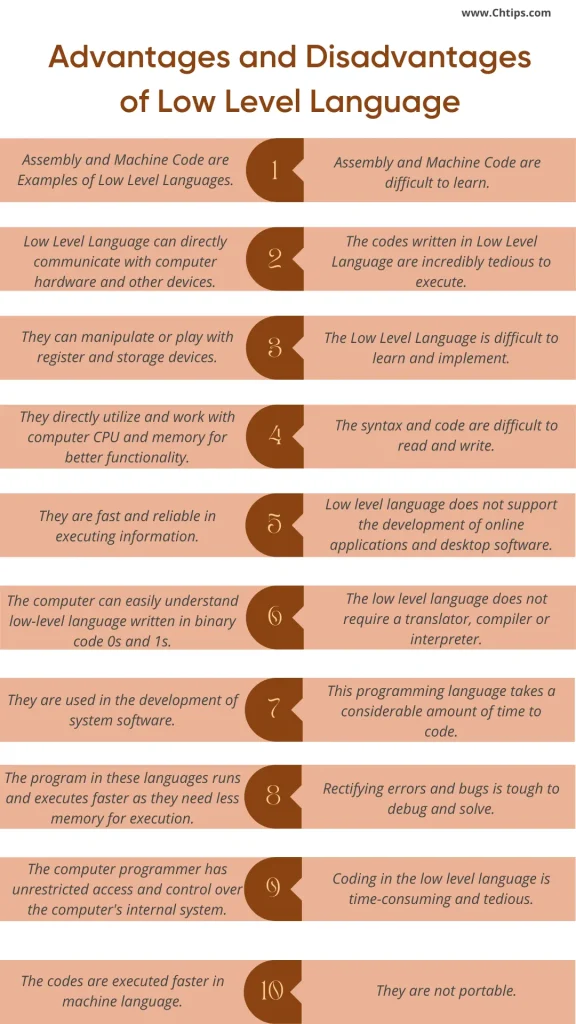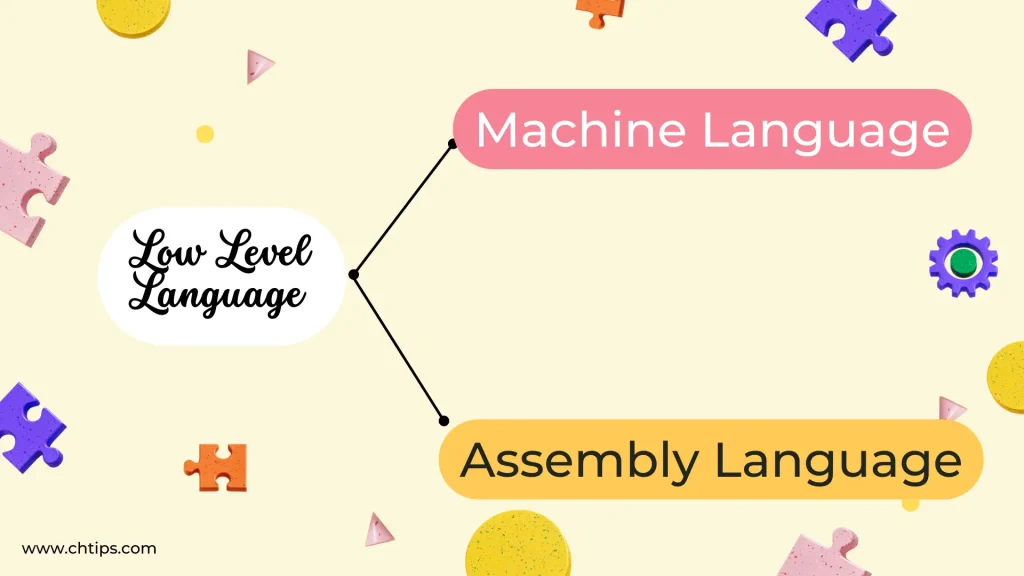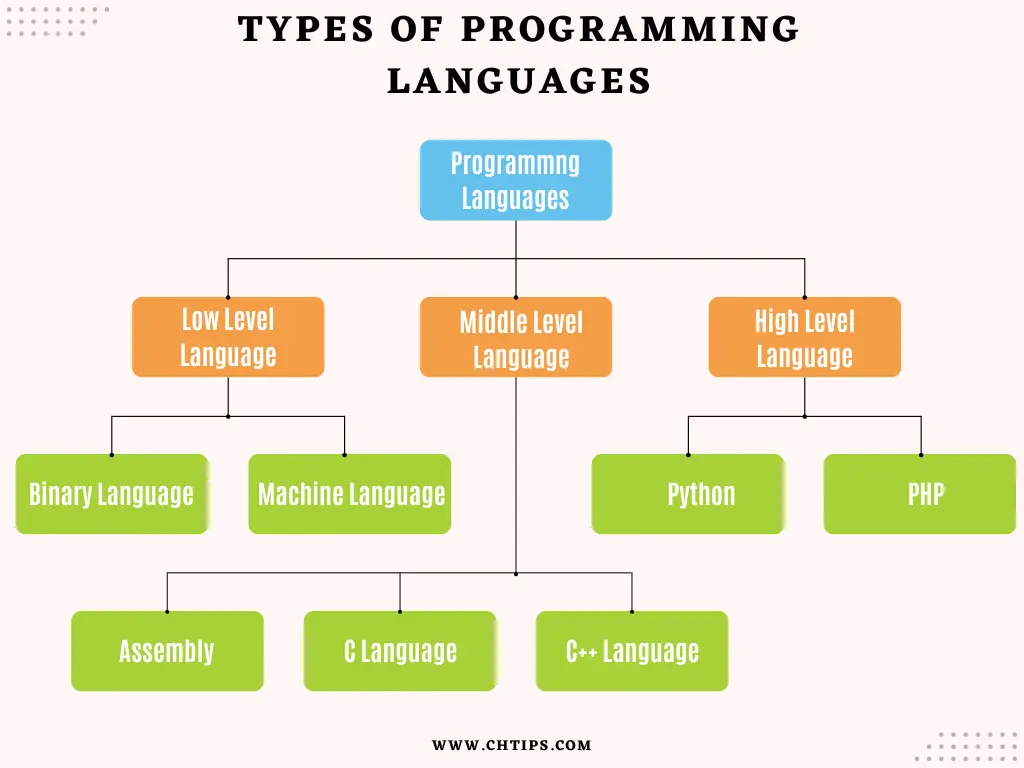A low-level language is a programming language that is less abstract than a high-level language.
It can be used directly by machines without processing it through another program or set of programs.
Let us learn some significant Advantages and Disadvantages of Low Level Language | Benefits and Drawbacks of Low Level Language.
What is Low-Level Language
Low level language use 0s and 1s [Binary Code] or [Binary Language]. Computer systems understand only binary language.
Low-level language is a programming language used in computer hardware and software.
It is called “low level” because it provides access to computer hardware and other electronic devices.
A low-level language allows you to write programs directly in assembly or machine code, which run directly on the CPU without help from higher-level languages like C++, Python or PHP.

Low-Level Languages use words and symbols to express the logic of computer programs, rather than using only numbers and letters like high-level languages such as C++ or Java.
They also allow you to program at a deficient level — meaning that your code runs directly on the processor’s internal operations without having any other processes intervene between them (such as memory management).
Low-level languages are also used for application development or shell scripting, where you write programs or scripts that run within an existing program or command line interface (CLI).
Low-level languages are typically used for system programming, which involves writing software that controls how the computer works and interacts with other devices.
Advantages and Disadvantages of Low Level Language | Pros and Cons of Low Level Language in Tabular Form
| # | Advantages of Low Level Language | Disadvantages of Low Level Language |
| 1 | Assembly and Machine Code are Examples of Low-Level Languages. | Assembly and Machine Code are difficult to learn. |
| 2 | Low-Level Language can directly communicate with computer hardware and other devices. | The codes written in Low-Level Language are incredibly tedious to execute. |
| 3 | They can manipulate or play with register and storage devices. | The Low-Level Language is difficult to learn and implement. |
| 4 | They directly utilize and work with computer CPU and memory for better functionality. | The syntax and code are difficult to read and write. |
| 5 | They are fast and reliable in executing information. | Low-level language does not support the development of online applications and desktop software. |
| 6 | The computer can easily understand low-level language written in binary code 0s and 1s. | The low-level language does not require a translator, compiler, or interpreter. |
| 7 | They are used in the development of system software. | This programming language takes a considerable amount of time to code. |
| 8 | The program in these languages runs and executes faster as they need less memory for execution. | Rectifying errors and bugs is tough to debug and solve. |
| 9 | The computer programmer has unrestricted access and control over the computer’s internal system. | Coding in a low-level language is time-consuming and tedious. |
| 10 | The codes are executed faster in machine language. | They are not portable. |
Advantages and Disadvantages of Low Level Language With Image

Explain What Machine Language is?
Machine languages are also known as Binary Code and Object Code.
The computer system does not understand a language other than machine language, i.e. 0s and 1s.
Machine language can be considered “Computer Language”.
The machine codes are complicated to write, understand and implement. They need a compiler and assembler for better functionality.
Binary codes 0s and 1s are used to write machine codes, and computers easily understand these binary codes to obtain desired results.
These languages are the first programming language. Software like the operating system is designed and developed using this language.
This language can easily communicate with hardware, which makes it easy to develop system drivers, spoolers, operating system, etc.
Machine language is a low level programing language.
Machine language works in two distinct methods.
- Opcode
- Location Counter
Explain What is Assembly Language
The Assembly language is a low-level programming language that uses mnemonics codes for better results and understanding.
The mnemonics codes can be understood and written easily to derive necessary results and outputs.
Assembly language codes can be implemented easily in projects to obtain results that suit our requirements.

The assembly language needs a compiler and translator. This language was designed and developed to solve the bugs and issues raised in machine language.
The computer system does not understand any human languages and signs. It can adequately work with binary numbers such as 0s and 1s.
In Assembly language, mnemonic codes are used instead of binary numbers. The commands used in mnemonics codes are easy to remember and execute.
In Assembly language, letters, symbols, and digits are used for better functionality and understanding.
Some Important Points to Remember.
- The issues are quickly tracked and solved in assembly language.
- There are fewer errors in assembly language compared to their counterparts.
- It is faster processing and handling of language.
- It is not a portable language.
- It can perform more complex tasks.
Types of Low-Level Language
Low level language is categorized into 2 different types.
- Machine Language.
- Assembly Language.
1. Machine Language
Machine language is a programming language that instructs computers on how to do their jobs.
Machine language resembles human languages because it has vocabulary, syntax, and grammar rules.
Any computer can understand a program written in machine language (assuming the computer understands the language).
This makes it very efficient for computers to receive instructions from humans or machines through machine language.
Each processor has its own unique set of instructions built into it, which enables computers to execute programs written in machine code more efficiently than if they were written in high-level languages like C++ or Java.
2. Assembly Language
Assembly language is a low-level programming language that makes writing programs run on a processor chip easier.
Assembly language is similar to high-level languages such as C and Java, but it uses mnemonics instead of syntax.
This makes assembly easier for people who need to learn to program in other languages.
The main advantage of assembly languages over high-level languages like C or Java is that it allows you more control over the operations performed by your computer system.
Most modern processors have built-in instruction sets, which make them easier to program in assembly than general-purpose CPUs found in older computers or laptop devices.
Assembly language is the most basic and essential form of programming.
It’s also a crucial skill for those who want to learn more about computer science, software engineering, and even electronics.
Assembly language is a low-level programming language that runs directly on your computer’s processor or CPU.
This makes it ideal for small programs that need to run fast without wasting memory (memory).
Examples of Low Level Language
- Machine Language.
- Assembly Language.

Uses of Low Level Language
| 1 | Operating System. |
| 2 | System Device Drivers. |
| 3 | Firmware. |
| 4 | BIOS |
| 5 | Compilers. |
| 6 | Translator. |
5 Features and Characteristics of Low Level Language
- Low-level languages are machine and assembly languages.
- The code is complex to read and execute.
- The machines easily understand Low-level language.
- It is challenging to write code in low-level language compared to high-level languages like PHP and Python. JavaScript, etc.
- The errors are very time-consuming to solve.
5 Differences Between Low Level Language and High-Level Language in Tabular Form
| # | Low-Level Language | High-Level Language |
| 1 | Low-Level Language is machine-friendly, as machines in binary code 0s and 1s can easily understand the instruction. | High-level languages are more programmer-friendly. |
| 2 | LLL is challenging to learn and execute. | HLL is simple to learn compared to low-level language. |
| 3 | They do not require an assembler and translator. | They require an assembler and translator. |
| 4 | They are not portable. | They are portable. |
| 5 | The code written in LLL is challenging to maintain. | They are simple to maintain and update according to the requirement. |
| 6 | They are tuff to debug errors and bugs in the code. | Errors and bugs can be resolved quickly. |
Different Types of Programming Languages

- Procedural Programming Language
- Functional Programming Language
- Scripting Programming Language
- Logic Programming Language
- Object-Oriented Programming Language [OOPs]
10 Examples of High-Level Language
People Are Also Reading
- Characteristics of Object Oriented Programming Languages
- Advantages and Disadvantages of Assembly Language
- Advantages and Disadvantages of PHP
- Why is C++ So Hard to Learn For Beginners
- What are the Importance of C Programming Language
- 10 Advantages and Disadvantages of Machine Language
- What Language is YouTube Written in
- Is Python Written in C
- Structure of HTML Document With Examples
- What is PLC [Programmable Logic Controller]
- 10+ Advantages and Disadvantages of High-Level Languages
- Advantages and Disadvantages of Subroutines
- Computer Basic Tutorials
Frequently Asked Questions [FAQs] Low Level Language Advantages and Disadvantages
Why is low-level Language Faster?
Low-Level languages are faster in execution and operation than high-level languages because they don’t need to convert the code.
Why is low-level Language Difficult for Humans?
The low-level language doesn’t need a compiler or interpreter. LLP uses binary code that is very difficult to remember and execute.
What is the Best low-level Language?
Machine Code or Assembly Language.
Is Python a low-level Language?
Python is a high-level language.
Is SQL a low-level Language?
SQL is a high-level language.
Is Matlab a low-level Language?
Matlab is a high-level language.
Who Invented low-level Language?
John McCarthy
What is Low-Level Language Called?
Machine Language
What is the First Low-Level Language?
Assembly Language
Is HTML a Low-Level Language?
HTML is not a programming language.
Get In Touch
I have also written and compiled some articles on computers and telecommunications, and please go through them.
I hope you will like reading it.
All the questions and queries related to 10 Advantages and Disadvantages of Low Level Language | Benefits and Drawbacks of Low Level Language with examples and images have been answered here.
If you have questions about the Pros and Cons of Low Level Language.
Don’t hesitate to contact me, and if you need to add, remove or update anything from the article, please let me know in the comment section or via email.
I will be more than happy to update the article. I am always ready to correct myself.
Please share this article with your friends and colleagues; this motivates me to write more on related topics.
!!! Thank You !!!
